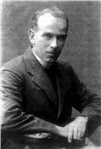
Ralph Norman Sharp
The Reverend Ralph Norman Sharp is best-known amongst Ancient Near Eastern and Iranian scholars for his accessible translation of monumental Old Persian cuneiform inscriptions, the first edition of which was published in 1966 by the Central Council of the Celebration of the 2500th Anniversary of the Founding of the Persian Empire by Cyrus the Great. He was born at Bushey Heath in Hertfordshire on 23rd June 1896, went to school at Westminster and then joined the Young Men’s Christian Association (YMCA) in April 1916. In October 1919 he went up to Queen’s College, Cambridge where he read Theology and Classics. He then joined the Anglican Church and became a missionary for the Church Missionary Society in 1925. He was sent to Iran where he lived for almost forty years. In the words of his old friend and former director of the British Council regional centre in Shiraz, the late Paul Gotch, O.B.E. (1915–2008), “Norman realised that to best do his job, to get into the minds and hearts of the people he had to learn their language. He had not only to speak but read it, write it, and translate it”. Sharp became fluent in speaking and writing Persian, revised the Persian Prayer Book, actively trained local men in the Church and served as an examining chaplain to successive bishops in Iran from 1935 to 1965. Soon after arriving in Iran he was located to Yazd where he served as pastor for eleven years and it was there that he designed, fund-raised and founded a new church. He then became pastor in Shiraz where he designed and consecrated the Church of St. Simon the Zealot (Kelisa-yé Moqaddas-é Sham'un-é Ghayur) in 1938. He went on to design two more churches in Qalat (1944) and Bushehr (1944). In all of these he incorporated decorative tilework with Biblical quotations in Persian and designed the stained glass windows with coloured glass reused from old Qajar houses.
Sharp was also a composer, organist and a sympathetic scholar of Persian literature. In 1954 he added the teaching of Old Persian cuneiform to the newly created Faculty of Letters at the University of Shiraz, later renamed Pahlavi University in 1962. Sharp officially retired from his Church position on 17th February 1965 but in 1960 he had already been appointed Assistant Professor in the University, remaining in post there until his retirement from Iran in 1967. Sharp used to give regular tours of Persepolis for VIP groups, including Her Majesty Queen Elizabeth II and Prince Philip on the occasion of their official visit to Iran in March 1961. In 1966 he published what remains a very useful introduction to Old Persian with copies, transliterations and translations of the major monumental inscriptions.
After returning to England, Norman Sharp retired to the Wiltshire market town of Chippenham. He was very reluctant to leave Iran and wrote to Bishop Hassan DehqaniTafti that “I count it an immense privilege to have been allowed to spend the greater part of my life in the service of the Church in Iran. I have long ago given my heart to Persia and her splendid people and especially to those who have entered the Persian Christian Church or Ministry”. It was here that he carried on translating Persian poetry into English and a book by Sayyed Muhammad Taqi Mostafavi, the former director of the National Museum in Tehran, entitled The Land of Pars. Norman Sharp finally passed away on 11th September 1995.
NOTE: "Table of Contents" in French and Persian may be viewed under "Select Images."
Introduction by St John Simpson
Preface
1. Old Persian Cuneiform.
2. Nouns.
3. Adjectives.
4. Adverbs
5. Numbers.
6. Pronouns.
7. Prepositions.
8. Verbs.
9. The Gold Tablet of Ariaramnes.
10. The Gold Tablet of Arsames.
11. The Inscriptions of Cyrus at Pasargadae.
12. The Cylinder Seal of Darius the Great.
13. The Inscription of Darius the Great at Behistan.
14. The Inscriptions of Darius the Great at Persepolis.
15. The Inscriptions of Darius the Great at Naqsh-i-Rustam.
16. The Inscriptions of Darius the Great at Susa.
17. The Inscription of Darius the Great in Egypt.
18. The Inscription of Darius the Great on Mount Alvand.
19. The Inscriptions of Xerxes at Persepolis.
20. The Stone Tablet of Xerxes found at Persepolis.
21. The Inscriptions of Xerxes at Susa.
22. The Inscription of Xerxes on Mount Alvand.
23. The Inscription of Xerxes at Van in Turkey.
24. The Inscription of Artaxerxes I at Persepolis.
25. The Inscriptions of Darius II at Susa.
26. The Inscription of Artaxerxes II at Susa.
27. The Gold Tablet of Artaxerxes II.
28. The Inscription of Artaxerxes II at Hamadan.
29. The National Figures supporting the throne on the facade of the royal tombs.
30 The Inscription of Artaxerxes III at Persepolis.
31. List of Old Persian words.